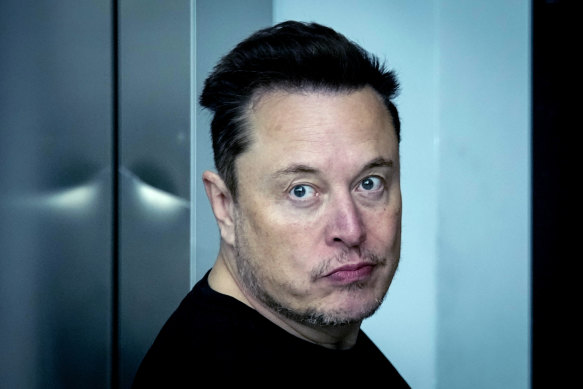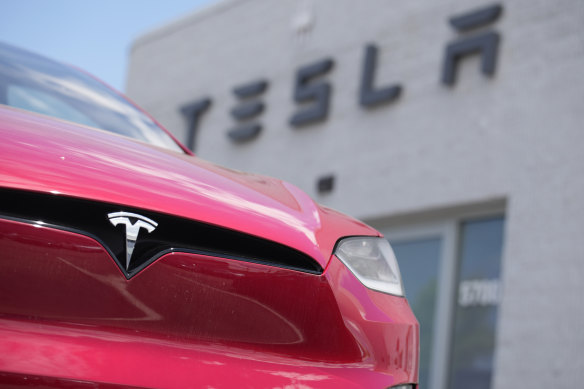This was published 1 year ago
Opinion
Elon Musk might be doing a lot of damage to Tesla
Stephen Bartholomeusz
Senior business columnistTesla has regained its position as the world’s biggest seller of electric vehicles. Not only may that title be short-lived, but it’s a hollow victory anyway.
On Tuesday, Tesla reported that it had sold 386,810 EVs in the first quarter of this year, well ahead of the 300,114 battery-only vehicles sold by Chinese rival BYD in the same period. BYD had, for the first time, surpassed Tesla in sales in the December quarter.

Has Elon Musk taken his eye off the ball at Tesla?Credit: AP
Tesla’s sales were, however, a long way short of the 457,000 vehicles that the Wall Street consensus had forecast, 20 per cent lower than its December-quarter sales, and 8.5 per cent lower than the same period last year. The results rattled investors, sending the stock 4.9 per cent lower and wiping about $US27.2 billion ($41.8 billion) off the value of the company.
While Tesla blamed a refresh of its Model 3, the arson attack that impacted its Berlin factory, and the disruptions to shipping in the Red Sea caused by Houthi attacks for the weak sales numbers, it produced 46,000 more vehicles than it sold during the quarter. The issue is demand, not supply.
With BYD’s sales also down heavily – it sold 526,409 EVs in the December quarter – there’s a question mark over whether the momentum in global demand for EVs has slowed.
Demand from early adopters may have been satiated, with question marks over the cost of EVs relative to internal combustion and hybrid vehicles, range, and the lack of ubiquitous charging infrastructure all holding the sector back.
BYD did disclose a big surge in sales in March, so the softness in the first two months might be attributable to the Lunar New Year celebrations (although they are usually a strong period of demand).
More likely, with a torrid price war occurring in China’s domestic market – from which BYD draws more than 90 per cent of its sales – consumers might be waiting for even better deals.
BYD has cut prices heavily across its entire range of EVs and hybrids and forced its domestic competitors, including Tesla, to follow suit in a market plagued by significant over-capacity and within an economy experiencing some significant challenges, including the weakness of consumer confidence and spending.
Tesla’s challenges might be related to the fact that, unlike its Chinese and Korean competitors, it has been slow to refresh its range of models. Its next new mass-market model isn’t due until late 2025 at the earliest.
They might also, however, relate to the brand damage being inflicted by Elon Musk, whose war on “wokeness” has alienated large parts of his potential customer base. Given the breadth of his other commercial interests, and his preoccupation with his social media platform X and tweeting, he might also have taken his eye off the Tesla ball.
Certainly, with demand for its vehicles waning – the year-on-year fall in sales was its first since the early days of the pandemic – and margins being crushed by the price war with BYD and other manufacturers in China, and its own price cuts as it has attempted to stimulate demand, Tesla is on the nose with investors.
The release of the March-quarter sales numbers drove Tesla’s share price down 5 per cent, taking their slump this year to more than 36 per cent. A company valued at $US1.3 trillion ($2 trillion) in late 2021 now has a market capitalisation of “only” $US530 billion, with Tesla no longer among the top 10 S&P 500 stocks.
Within the broader industry, while there are some new emerging success stories – South Korea’s Kia and Hyundai had spectacular growth in US sales during the March quarter, with Kia more than doubling its sales and Hyundai’s up 75 per cent – the major US manufacturers are starting to hedge their bets, with some shifting their emphasis towards the increasingly successful Toyota-led strategy of prioritising hybrids over battery-only EVs.

Tesla’s problems are not about supply. It’s demand.Credit: AP
Separate to the challenge of maintaining growth in demand for EVs, the manufacturers – including Tesla, given that its key plant is in China – have also found themselves caught up in the intensifying, broader trade tensions that have undermined decades of globalisation.
Only a week ago, China referred the US to the World Trade Organisation (WTO), complaining that its Inflation Reduction Act – which denies tax credits for vehicles containing parts, including the raw materials for batteries, from “foreign entities of concern” (read China) – was discriminatory, distorted competition and breached WTO rules.
That is almost laughably hypocritical. China’s EV industry was built on tens, if not hundreds, of billions of government incentives and subsidies.
While the $88 billion of incentives to buy EVs that were in place between 2016 and 2022 (and which were only some of a myriad of central and local government measures to provide financial assistance to the sector) have been phased down, earlier this year Beijing created a new four-year scheme that exempts vehicles from up to $6500 of sales tax this year, albeit reducing to $3200 in 2026 and 2027.
The French have created an incentives scheme that gives preference to European-manufactured EVs over those made in China.
The European Union has foreshadowed tariffs on Chinese-made EVs in response to China’s subsidies, and has a “carbon border adjustment mechanism” that will eventually tax imports from China for their embedded carbon (which will impact EV manufacturers reliant on cheap and subsidised coal-fired power).
Even relatively open economies like Australia have their own incentives to help drive the take-up of EVs.
There isn’t, therefore, anything remotely resembling a free trade in EVs, and it’s unlikely there ever will be one.
China will continue to subsidise, directly and indirectly, a sector that was designed to leap past the entrenched internal combustion engine technology leadership of the West, dominate its huge domestic market and the supply chains for EVs, and then leverage that platform into new global export industries.
The US and Europeans, late to understand the threat, will now do whatever it takes to protect their own automotive industries.
China’s dominance of EV sales (its domestic market is roughly half the global market for EVs) and of the supply chains for EVs means that protection from what would otherwise be a flood of cheap – but technically competitive or even superior – exports from a vast Chinese manufacturing base with capacity well above the domestic demand will come at an economic cost.
As the federal government’s planned $1 billion fund for domestic solar-panel manufacturing suggests, however, governments are willing to pay that price to prevent China from gaining global dominance over the green technologies regarded as vital to the next several decades of economic activity – and to the response to climate change.
EVs are a core element of those inevitably intertwined economic and environmental ambitions.
The Business Briefing newsletter delivers major stories, exclusive coverage and expert opinion. Sign up to get it every weekday morning.